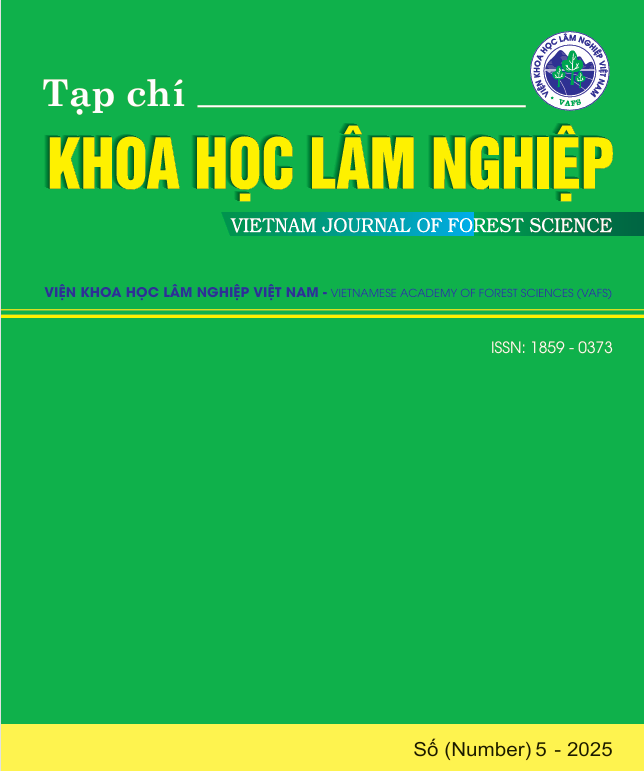STUDY ON SOME STRUCTURAL AND REGENERATION CHARACTERISTICS OF FOREST STANDS WITH Dalbergia cochinchinensis Pierre ex Laness. DISTRIBUTION IN THE CENTRAL HIGHLANDS
DOI:
https://doi.org/10.70169/VJFS.1109Keywords:
Dalbergia cochinchinensis Pierre ex Laness, structure, high tree layer, regenerated tree layer, biodiversityAbstract
Dalbergia cochinchinensis Pierre ex Laness is a rare large timber tree species under Fabaceae family, listed in the CITES Convention, the IUCN Red List, Decree 84/2021/ND-CP and the Vietnam Red Book. The study was conducted in three provinces of Kon Tum, Gia Lai and Dak Lak. The results determined that at rich natural broadleaf evergreen forest, the composition of the high tree layer was averagely 35 species, the average density of the high tree layer was 601 trees/ha, the average wood volume was 266.3 m3/ha, the average wood volume of D. cochinchinensis was 11.6 m3/ha, the composition of the regenerated tree layer was averagely 11 species, the average density of regenerated trees was 13,500 trees/ha, the rate of prospective regenerated trees was 7.42%. As for the poor natural broadleaf evergreen forest, the corresponding indicators were 69 species, 1,769 trees/ha, 96 m3/ha, 2.5 m3/ha, 23 species, 28,583 trees/ha and 20.86%, respectively. For poor semi-deciduous broadleaf natural forests, the corresponding indices were 42 species, 1,813 trees/ha, 61.9 m3/ha, 5.5 m3/ha, 15 species, 13,250 trees/ha and 8.28%, respectively. For medium deciduous broadleaf natural forests, the corresponding indices were 24 species, 747 trees/ha, 133.4 m3/ha, 1.4 m3/ha, 9 species, 12,333 trees/ha and 1.73%, respectively. The forest stands had 2-3 layers. The distance distribution simulated well the N/D1.3 structure of the stands. The species richness (R) and Margalef (d) index were highest in poor natural broadleaf evergreen forests, at 3.299 and 11.181, respectively. Evenness index J’ and Shannon-Wiener species diversity index (H) did not differ among the study areas.
References
1. Bộ Nông nghiệp và Phát triển nông thôn, 2018. Thông tư số 33/2018/TT-BNNPTNT ngày 16 tháng 11 năm 2018, Thông tư quy định về điều tra, kiểm kê và theo dõi diễn biến rừng.
2. Chính phủ Cộng hòa xã hội chủ nghĩa Việt Nam, 2021. Nghị định số 84/2021/NĐ-CP ngày 22 tháng 9 năm 2021, Nghị định sửa đổi, bổ sung một số điều của nghị định số 06/2019/NĐ-CP ngày 22 tháng 01 năm 2019 của chính phủ về quản lý thực vật rừng, động vật rừng nguy cấp, quý, hiếm và thực thi công ước về buôn bán quốc tế các loài động vật, thực vật hoang dã nguy cấp.
3. Trần Cao Nguyên, 2024. Nghiên cứu hoàn thiện các biện pháp kỹ thuật tạo giống và trồng rừng thâm canh theo hướng đa mục đích hai loài Trắc và Giổi xanh tại tỉnh Gia Lai, Báo cáo tổng kết đề tài nghiên cứu ứng dụng khoa học công nghệ cấp tỉnh.
4. Trần Hồng Sơn, 2019. Điều tra, đánh giá một số đặc điểm lâm học và tăng trưởng làm cơ sở phát triển loài Giổi nhung (Paramichelia braianensis Dandy) theo hướng kinh doanh gỗ lớn ở Kon Hà Nừng, Tây Nguyên. Luận án Tiến sĩ lâm nghiệp.
5. Curtis, J.T. and McIntosh R.P., 1951. An upland forest continuum in the Prairie forest border region of Wisconsin. Ecology 32: pp. 476 - 496.
6. Daniel Marmillod, 1982. Methodology and results of studies on the composition and structure of a terrace forest in Amazonia. Doctorate. Georg - Augus - University of Göttingen - Göttingen.
7. Margalef R. F.,1958. Information theory in ecology. International Journal of General Systems, vol. 3, pp. 36-71, 1958.
8. Shannon, C. E. and W. Wiener., 1963. The Mathematical Theory of Communication. Illinois: Urbana University, Illinois Presss.









